Plants of the Park

As you make your way through the park, you'll notice the lush vegetation that surrounds you. We've taken the time to briefly acquaint you with some of the plants you will be seeing.
Plant Categories
Some plants are indigenous, meaning they were brought to the islands naturally by means of what we call the three W's - winds, waves, or the wings of an animal. Other plants are introduced, and they were brought here by canoe with the Polynesians who first inhabited these islands. Lastly, alien species are those brought here by human means after 1778, the first contact with the Western world.
Indigenous Plants
- Naupaka Kahakai
- Lauaʻe
Indigenous & Polynesian Introduced Plants
These plants both existed in the Hawaiian islands before Polynesians arrived and were also brought along with the Polynesians.
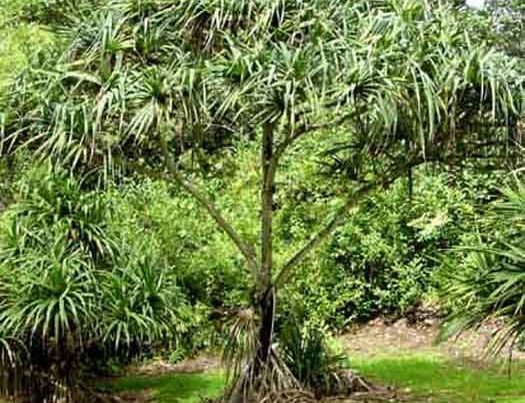 Hawaiian Name(s): hala, pū hala, lauhala Status: indigenous Medicines: The hala fruit is made part of a treatment for ‘ea and pa‘ao‘ao. The aerial roots are used in medications for childbirth and a skin disorder. They are combination with pohepohe (Hydrocotyle verticillata), kohekohe (Eleocharis spp.), hala leaf buds, ‘ala‘ala wai nui pehu (Peperomia spp.), ‘ihi makole (Oxalis corniculata), naio leaf buds, fruit, and leaves (Myoporum sandwicense), niu (coconut, Cocos nucifera), kukui flowers (Aleurites moluccana), noni fruits (Morinda citrifolia), and kō (Saccharum officinarum). The leaves are also use for weaving. | 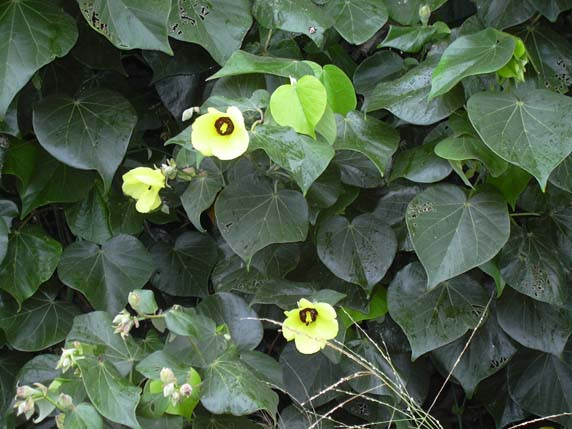 Hawaiian Name(s): hau, hau ka‘eka‘e Status: indigenous? Medicines: The flower buds and sap used as laxative and for ‘ea and pa‘ao‘ao. That may be followed with an enema made from noni fruit (Morinda citrifolia). Sap from the bark was scraped and mixed with sap from the kikawaio fern (Christella cyatheoides) and ‘uwi‘uwi (cf. Conyza spp.), with root bark from ‘uhaloa (Waltheria indica) and pōpolo (Solanum americanum) for chest congestion.The leaf buds were chewed/swallowed for dry throat. The inner bark (with sap) was soaked and drunk for labor pains and rubbed on stomach (Chun 1994:83–86). Sap used as an internal lubricant as a mild laxative and to facilitate the passage of a fetus through the birth canal (Abbott 1992:101). | 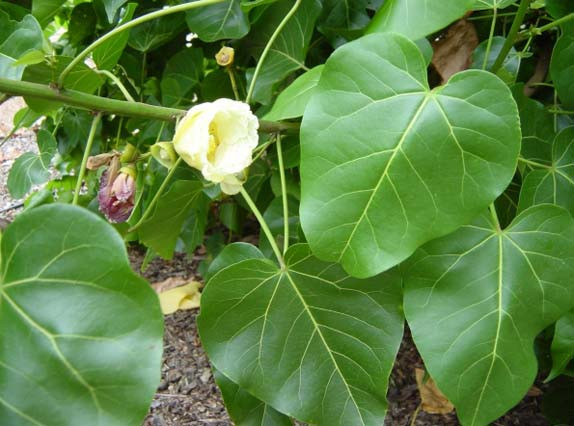 Hawaiian Name(s): milo Status: indigenous? Non Medicinal Uses: Milo may have been brought by the Polynesians for wood and fiber (Wagner et al. 1990:902); made into "beautiful bowls" for poi (Krauss 1993:22; Malo 1951:23); fruit for yellowish-green dye (Krauss 1993:66); canoe hulls (Abbott 1992:80). Young leaves edible (Lucas 1982: 56). |
Hau is also associated with the story of the akua moʻo, the caretaker of the Keʻalohi and Heʻeia pond.
Polynesian Introduced Plants
- ʻOhe (bamboo)
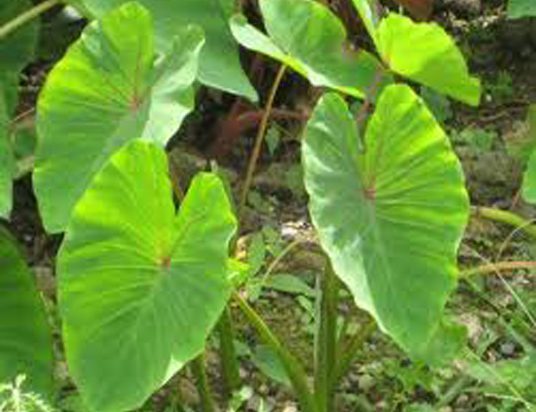 Hawaiian Name(s): kalo Status: Polynesian introduction Medicines: There are numerous varieties of kalo, some if which are favored over others in medicinal treatments. These include kalo lauloa, kalo ‘api‘i, kalo mana, kalo hāpu‘u ke‘oke‘o, kalo uahiapele, kalo manini,kalo ‘apuwaike‘oke‘o, kalo haokea mana, and kalo pi‘iali‘i (Chun 1994:134). Abbott notes that the cut end of a petiole used to stop wounds from bleeding; stem leaf rubbed on insect bites to prevent swelling & pain; juice consumed to reduce fever. | 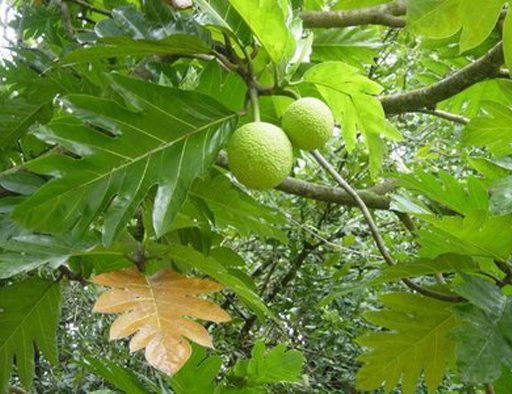 Hawaiian Name(s): ‘ulu Status: Polynesian introduction (not naturalized) Medicines: To treat koko‘ino (bad blood), one can combine the bark of ‘ulu with that of ‘ahakea (Bobea spp.), ‘ohi‘a (Metrosideros spp.), ‘uhaloa (Waltheria indica), ‘auko‘i (Senna occidentalis) and kō kea (white sugarcane, Saccharum officinarum) along with the flowers and leaves of ko‘oko‘olau (Bidens spp.); these items are mixed into a liquid form and to be taken three times daily | 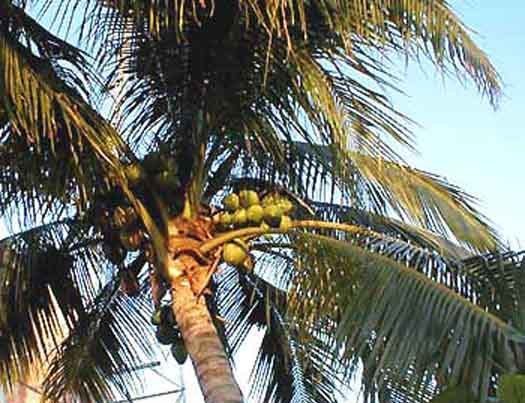 Hawaiian Name(s): niu, ololani Status: Polynesian introduction Medicines: Niu flesh, oil, leaf buds, and water were used in numerous medicines (see other plants). These include formulations for lepo pa‘a (constipation), ‘ea (thrush), pa‘ao‘ao, and the "illness related to lolo"; in addition, the leaf bud is made into a topical medicine for ‘eha moku kukonukonu and ‘eha ‘ulia wale (Chun 1998:41). |
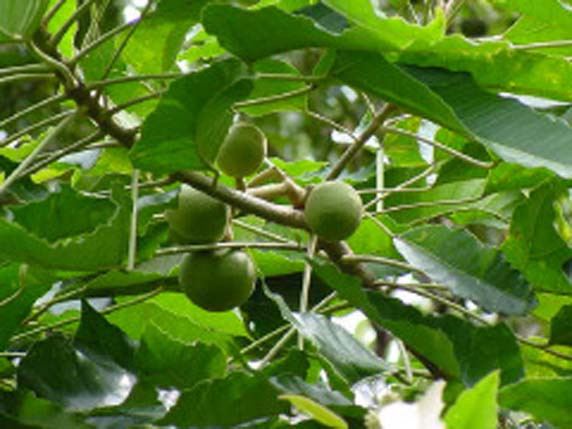 Hawaiian Name(s): kukui, kuikui Status: Polynesian introduction Medicines: For ‘ea and paa‘ao‘ao the flowers and endosperm (nut) of the kukui are combined with ‘ala‘alawainui pehu stems (Peperomia spp.), ‘ohi‘a ‘ai bark (Syzygium malaccense), ‘aka‘akai ‘oliana (?onion, Allium cepa) bulb, noni fruit (Morinda citrifolia), kō kea (white sugarcane, Saccharum officinarum), and possibly kikania (Desmodium sandwicense). Ingedients are mashed and strained, and liquid ingested. For infected sores, including puho ‘a‘ai, the green flesh of the kukui | 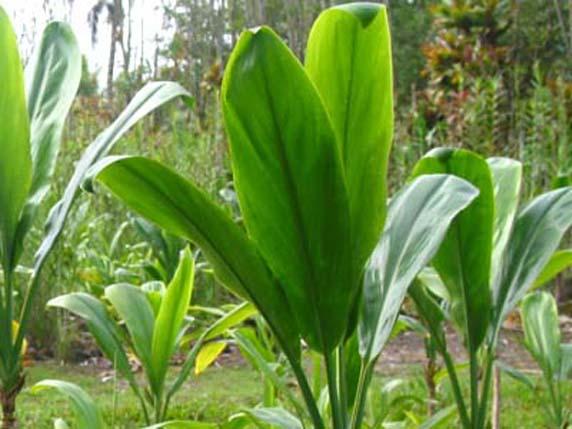 Hawaiian Name(s): kī Status: Polynesian introduction Medicines: Kī has many medicinal uses. For treatment of i‘aku o ka ihu (nasal growth) kī flowers are combined with rhizomes (underground stems) of ‘ōolena (Cucurma longa), ‘awapuhi kuahiwi (Zingiber zerumbet), and ‘awapuhi lei (Hedychium coronarium), as well as powdered ‘iliahi (Santalum spp.) and naio (Myoporum sandwicense). For hano (ho) maka‘u i ke kanaka, kī flowers are added to pith of the ‘ama‘uma‘u fern (Sadleria cyatheoides) and ‘ōkaha (birdsnest fern, Asplenium nidus), and taken internally with poi and other foods. Treatment for shortness of breath/asthma (nae, nae‘oiku, nae hokale ‘ano ohaohao) kī flowers and leaf buds are mixed with ‘uhaloa root bark (Waltheria indica), ‘ala‘ala wai nui pehu (Peperomia spp.), noni fruit (Morinda citrifolia), ‘uala huamoa (sweet potato, Ipomoea batatas), possibly pu (squash, Cucurbita spp.), and kō kea (white sugarcane,Saccharum officinarum). | 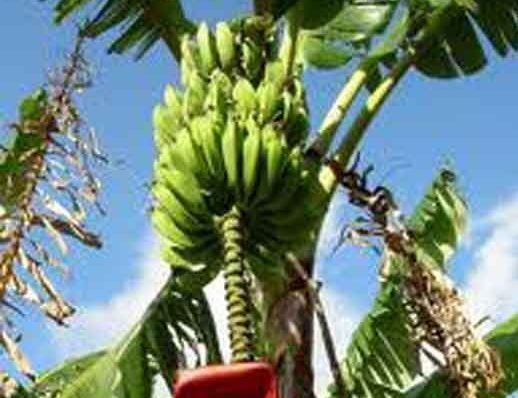 Hawaiian Name(s): mai‘a Status: Polynesian introduction Medicines: There are numerous varieties of mai‘a (banana, Musa spp.) that have medicinal uses. These include the use of dried leaves, which are burnt and eaten with poi for intense heart burn. Also, this and hou nui o ke kino (profuse sweating) are treated with palaholo mai‘a, hau ke‘ake‘a bark, Palolo and ‘alaea clays, kō kea, kikawaioa leaf shoots (Christella cyatheoidea); this medicine is used in conjunction with ko‘oko‘olau and moa nahele tea. Forms of ‘ea, pa‘ao‘ao, pala, and ‘ukihi are treated with a medicine made of the sap of the flowers and pohuli (root sucker), mixed with sap from green kukui fruits (Aleurites moluccana) and he‘i (papaya, Carica papaya). Another variety of mai‘a is used to treat ‘ea and pa‘ao‘ao, this medicine uses the immature flowers and sheath, with ‘alaea clay, ‘ana (sponge, Leiodermatium spp.), and green kukui fruit. |
Introduced Plants
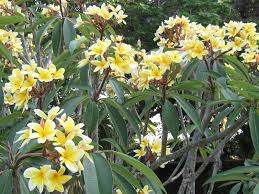 Scientific Name: Frangipani Status: Introduction Non Medicinal Uses: The flowers of these beautiful plants are used in making traditional Hawaiian leis. They are highly fragrant and bloom freely from spring throughout fall in multiple colors like white, yellow, pink, and red. These flowers stand out nicely amid the large leaved foliage, which may be evergreen or deciduous, depending on the type. | ||
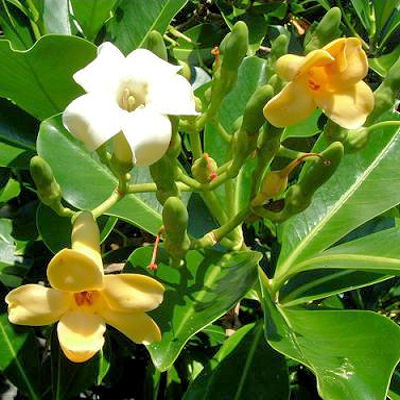 Scientific Name: Fagraea Berteriana Status: Introduction Non Medicinal Uses: The flowers of these beautiful plants are used in making traditional Hawaiian leis. Also known as the perfume flower tree, ten cent flower, pua tonga or pualulu… as locals would say, “same smell different name!” The pua kenikeni is one of the most fragrant blooms anywhere. Indigenous to Northern Australia and the Caroline Islands, the pua kenikeni can be found growing from near sea level to about the 3500 feet in elevation. Widely spread throughout the Pacific, it was introduced to Hawai‘i in modern times as an ornamental addition to the garden. It obtained the nickname “perfume flower tree” because its fragrance highly sought to produce scented coconut oils and perfumes. |
